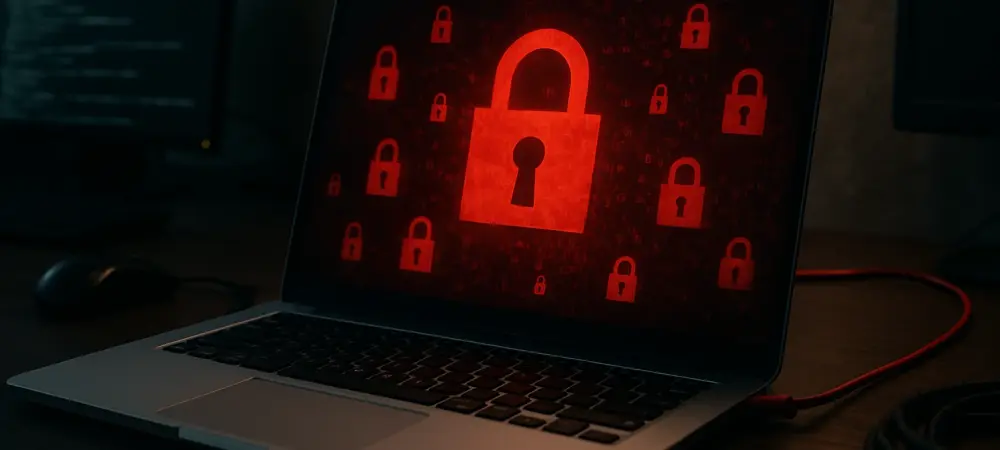Setting the Stage for a Growing Cyber Threat
Imagine a hospital network suddenly grinding to a halt, patient records locked behind unbreakable encryption, and life-saving equipment rendered useless as cybercriminals demand millions in ransom. This chilling scenario is not a distant possibility but a stark reality faced by countless organizations worldwide. Ransomware, a malicious software that locks data or systems until a payment is made, has evolved from a niche threat to one of the most pressing cybersecurity challenges of the digital age. With attacks growing in sophistication, the stakes have never been higher for businesses, governments, and individuals alike. This review delves into the technology behind ransomware strategies, exploring how these threats have transformed and what this means for defense mechanisms today.
Core Features of Ransomware Technology
Encryption and Data Theft as Foundational Tools
At the heart of ransomware technology lies encryption, a mechanism that transforms accessible data into an unreadable format, effectively locking victims out of their own systems. Attackers pair this with data exfiltration, stealing sensitive information to amplify pressure by threatening to leak it publicly. This combination has proven devastatingly effective, often forcing organizations to weigh the cost of ransom against reputational damage. High-profile incidents, such as attacks on major corporations, demonstrate how these core features exploit both technical vulnerabilities and human desperation, securing hefty payouts for cybercriminals.
Multi-Layered Extortion Models
Beyond basic encryption, ransomware has evolved into more complex extortion models, often dubbed double or triple extortion. In these scenarios, attackers not only encrypt data and steal it but also threaten to disrupt operations or target third parties connected to the victim. This multi-layered approach intensifies the psychological and financial toll, as victims face cascading consequences from downtime to potential lawsuits. The technology behind these threats often involves intricate planning, with malware designed to disable backups or infiltrate connected networks, leaving little room for recovery without payment.
Performance and Impact of Evolving Strategies
Targeting High-Stakes Sectors
Ransomware performance has been turbocharged by a strategic shift toward critical infrastructure sectors like healthcare, energy, and government. These targets promise maximum disruption and a higher likelihood of ransom payment due to the catastrophic consequences of downtime. The technology leverages tailored malware to exploit sector-specific vulnerabilities, such as outdated systems in hospitals or sprawling networks in utilities. The result is a heightened impact, where a single attack can paralyze entire communities, underscoring the ruthless efficiency of modern ransomware campaigns.
Stealth and Access Techniques
Another leap in ransomware performance comes from stealth tactics like “living off the land,” where attackers use legitimate tools within a target’s environment to blend in and evade detection. Coupled with this is the increasing reliance on social engineering, such as phishing emails crafted with alarming precision to trick employees into granting initial access. These methods showcase the adaptability of ransomware technology, minimizing the footprint of malicious code while maximizing infiltration success, often leaving traditional antivirus solutions scrambling to catch up.
Operational Sophistication and Accessibility
Business-Like Structures in Cybercrime
The operational side of ransomware has seen a dramatic shift toward professionalization, with cybercriminal groups mirroring legitimate businesses. Specialized roles, from developers to negotiators, and even customer support for victims, highlight a chilling efficiency. The technology is supported by robust communication platforms and dark web marketplaces, enabling seamless coordination. This structure not only boosts the scale of attacks but also ensures a polished experience for both attackers and, ironically, their targets, making ransom negotiations eerily transactional.
Democratization Through Ransomware-as-a-Service
Perhaps the most alarming development in ransomware technology is the rise of ransomware-as-a-service (RaaS). This model allows developers to lease or sell their malicious tools to less-skilled attackers, drastically lowering the barrier to entry. Hosted on accessible dark web platforms, RaaS kits come with user-friendly interfaces and detailed guides, turning cybercrime into a plug-and-play operation. This democratization fuels a surge in attack volume, as even novice criminals can deploy sophisticated ransomware, amplifying the global threat landscape.
Real-World Consequences and Challenges
Devastation Across Key Industries
The real-world performance of ransomware technology is most evident in its toll on high-value industries. Healthcare systems have been crippled, with patient care delayed during critical moments, while government agencies face breaches of sensitive data that undermine public trust. Critical infrastructure, such as power grids, has also been targeted, with attacks revealing the fragility of essential services. These incidents illustrate how ransomware transcends mere financial loss, striking at the core of societal stability with alarming precision.
Barriers to Effective Defense
Despite advancements in cybersecurity, defending against ransomware remains a daunting task. Traditional tools like firewalls often fail against tactics that exploit legitimate software or human error. Tracing attacks is equally challenging, as anonymizing technologies and cryptocurrency payments obscure the culprits. Regulatory and international hurdles further complicate efforts to dismantle criminal networks, leaving organizations to grapple with a threat that outpaces many current defensive capabilities and demands a rethinking of security paradigms.
Final Thoughts and Path Forward
Reflecting on this deep dive into ransomware technology, it becomes clear that the landscape has shifted dramatically from simple encryption schemes to intricate, multi-faceted attack strategies. The performance of these tools, marked by stealth, targeted precision, and operational sophistication, has outstripped many conventional defenses. The verdict is sobering: while ransomware poses a formidable challenge, it also exposes critical gaps in preparedness across industries.
Looking ahead, the focus must pivot to actionable solutions. Organizations should prioritize layered security approaches, integrating advanced threat detection with regular employee training to counter social engineering. Investment in robust backup systems that withstand encryption attacks emerges as a non-negotiable step. On a broader scale, international collaboration and stricter regulations around cryptocurrency transactions could disrupt the financial backbone of ransomware operations. By fostering innovation and collective action, there lies a tangible opportunity to reclaim ground from cybercriminals and build a more resilient digital future.

